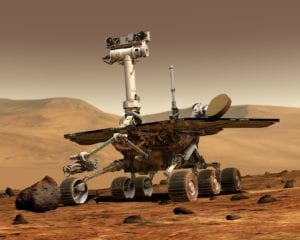Mankind will, no, will have to colonize space – because it does not have infinite time on earth. Elon Musk, founder of Tesla and SpaceX, was convinced of this last weekend in Boca Chica, Texas, where he presented the prototype of his Mars spaceship. In the not too distant future, the starship is to fly people to the Red Planet and even back to Saturn. According to Musk, this could already be the case in 2025. Completely unrealistic, say government agencies like Nasa and Esa. It will take much longer.
But is it really only a question of time? Will humans ever set foot on Mars? And is a human footprint on the Red Planet worth several hundred billion euros?
Yes, say many space travel enthusiasts. No, say the politicians – because there is no motive. At the latest since Nasa, the world’s leading space agency, under George Bush the Elder estimated the costs at a good 400 billion dollars at the beginning of the 1990s, the subject of Mars has been settled for large parts of politics. For almost three decades, this led to the US presidents’ mission ping-pong in print. As a result, it was not exactly en vogue in established spaceflight circles to talk seriously about manned missions to the planet many millions of kilometers away.
The supposedly high costs should not be an obstacle. Within an international cooperation and stretched over 10 to 20 years, they would be quite affordable for the leading space nations. Rather, the political motive is missing, a geopolitical competition of systems as once in Apollo, or a compelling business model that could justify the use of so much tax money as a profitable investment. Perhaps it is once again private spaceflight that provides new motivation for government institutions.
Musk has reawakened manned space flight
In 2002 Elon Musk, at that time still completely untouched by space travel, searched for a Martian plan on the web pages of Nasa. He found none. According to Musk, his foundation of SpaceX since then has served only one purpose: to land humans on Mars. The plan may sound presumptuous in view of its limited funds – even the National Research Council’s last official cost estimate for 2014 was still $300 billion. But his appearance at the International Astronautical Congress in Mexico in 2017, where he presented his plans for a trip to Mars, is considered a revival experience for manned space travel beyond the moon.
It is no coincidence that Nasa has also been more proactive in dealing with this topic ever since. This can be read, among other things, in the Global Exploration Roadmap, which serves worldwide as a rough guide to deeper space, with Mars as an astronautical long-range destination. This is because Nasa has never fundamentally lost sight of missions into deep space and has been working on the heavy-duty rocket SLS, the Space Launch System, and the Orion spaceship for almost two decades. The spacecraft have had to change their name and even their area of operation several times for political reasons, which has earned Nasa harsh criticism. But in this way, the employees were able to keep an eye on Mars without irritating the changing administrations in Washington too much. The contributors knew: At some point Mars will be back on the agenda. And indeed, with the Space Policy Directive 1, President Donald Trump wants to send people first to the moon (“to the moon …) and – at some point – even further, to Mars (…and beyond”) in the near future.
In a few years, according to the Americans’ plan known as Artemis, astronauts will first fly to a moon space station that is still to be built, and a human being will land on the surface again as early as 2024. This time, however, a woman and a man. Because a landing ferry is urgently needed for this more than ambitious schedule, Nasa is already distributing millions to companies for concepts, even though the US Congress has not yet given the necessary budget the green light. The participation of Europe is similarly uncertain. Whether it will be part of this project will only be decided by the European Council of Ministers conference this November.
Even if it displeases impatient Mars enthusiasts, from the astronauts’ point of view the detour makes sense. “For us it is clear: Mars missions will not come until we have successfully landed on the moon,” says Esa astronaut Matthias Maurer, for example, who will soon be flying to the International Space Station. Only there, he says, can people learn the skills they will need later on Mars. “If I were to fly to Mars with the current technology, I would have to stuff everything I need for the entire flight into the rocket – provisions, air and water, fuel – and in the end there would be no more room for experiments. So I ask myself why one should undertake such a long journey. To put up a flag again? Merely having been there cannot be the only purpose”. It would make much more sense to take everything you only need for the outward flight, says Maurer, and fill the remaining space with research equipment. After all, many things that people need for survival and for the return journey are already found as so-called in-situ resources on site: Water ice in the ground, carbon dioxide in its (very thin) atmosphere – and the Martian soil itself. In theory, drinking water, oxygen, fuel and building materials could be extracted from these resources. Problem: It is not that simple. Almost all of the necessary technologies still need to be developed. Even Elon Musk does not have them.





